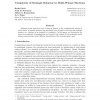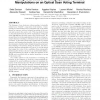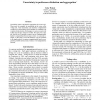160 search results - page 4 / 32 » Approximability of Manipulating Elections |
113
click to vote
SIAMCOMP
2011
14 years 2 months ago
2011
The Gibbard-Satterthwaite theorem states that every non-dictatorial election rule among at least three alternatives can be strategically manipulated. We prove a quantitative versi...
106
Voted
JAIR
2008
14 years 11 months ago
2008
Although recent years have seen a surge of interest in the computational aspects of social choice, no specific attention has previously been devoted to elections with multiple win...
88
Voted
SAC
2009
ACM
15 years 4 months ago
2009
ACM
The firmware of an electronic voting machine is typically treated as a “trusted” component of the system. Consequently, it is misconstrued to be vulnerable only to an insider...
85
Voted
AAAI
2007
15 years 2 months ago
2007
Uncertainty arises in preference aggregation in several ways. There may, for example, be uncertainty in the votes or the voting rule. Such uncertainty can introduce computational ...
85
Voted
CORR
2006
Springer
14 years 11 months ago
2006
Springer
We study the complexity of influencing elections through bribery: How computationally complex is it for an external actor to determine whether by paying certain voters to change t...



